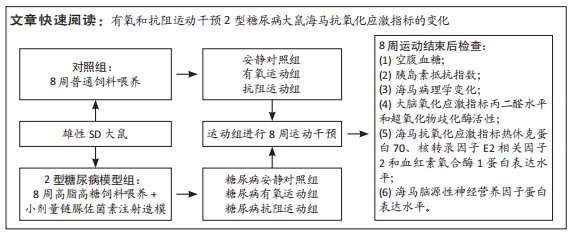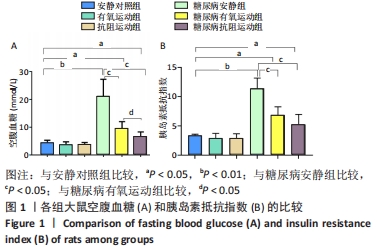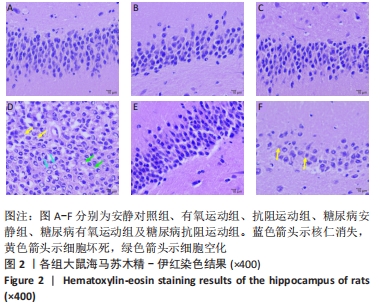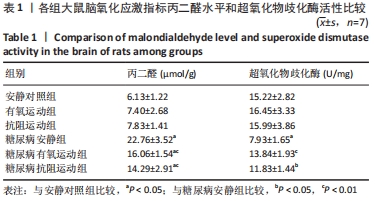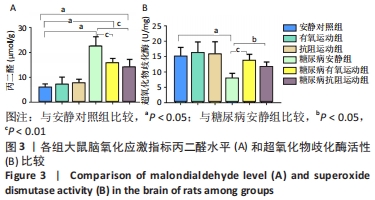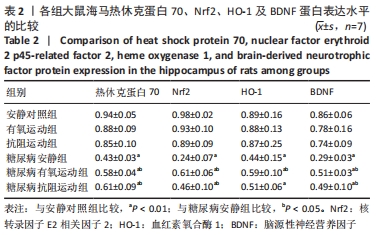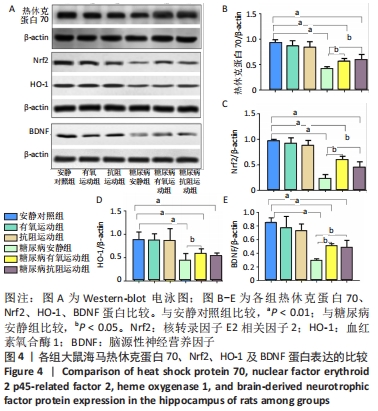[1] FAZELZADEH M, AFZALPOUR ME, FALLAH MZ, et al. The effects of voluntary complex and regular wheel running exercises on the levels of 8-oxoguanine DNA glycosylase, semaphorin 3B, H2O2, and apoptosis in the hippocampus of diabetic rats.Brain Behavior. 2021;11(3):e01988.
[2] RAHMATI M , KESHVARI M , MIRNASOURI R, et al. Exercise and Urtica dioica extract ameliorate hippocampal insulin signaling, oxidative stress, neuroinflammation, and cognitive function in STZ-induced diabetic rats. Biomed Pharmacother. 2021;139:111577.
[3] YI HJ,HUANG GY,ZHANG K, et al.HSP70 protects rats and hippocampal neurons from central nervous system oxygen toxicity by suppression of NO production and NF-κB activation. Exp Biol Med. 2018;243:770-779.
[4] 钟静玫,郭强,陈辉,等.慢性温和应激后老年大鼠抑郁症状及HSP70的变化[J].中国老年学杂志,2015,35(3):740-742.
[5] ZHANG SY, YUAN LL, ZHANG LH, et al. Prophylactic Use of Troxerutin Can Delay the Development of Diabetic Cognitive Dysfunction and Improve the Expression of Nrf2 in the Hippocampus on STZ Diabetic Rats. Behav Neurol. 2018;2018:8678539.
[6] JIANG T, WANG XQ, DING C, et al.Genistein attenuates soflurane-induced neurotoxicity and improves impaire spatial learning and memory by regulating cAMP/CREB and BDNF-TrkB-PI3K/Akt signaling. Korean J Physiol Pharmacol. 2017;21:579-589.
[7] JANARDHANAN A, SADANAND A, VANISREE AJ. Nardostachys jatamansi targets BDNF-TrkB to alleviate ketamine-Induce Schizophrenia-Like symptoms in rats. Neuropsychobiology. 2016;74:104-114.
[8] NADIMI H, DJAZAYERY A, JAVANBAKHT MH, et al. Effect of vitamin D supplementation on CREB-TrkB-BDNF pathway in the hippocampus of diabetic rats. Iran J Basic Med Sci. 2020;23:117-123.
[9] WARD R ,LI WL ,ABDUL Y, et al. NLRP3 inflammasome inhibition with MCC950 improves diabetes-mediated cognitive impairment and vasoneuronal remodeling after ischemia. Pharmacol Res. 2019;142:237-250.
[10] 唐量,亢依婷,尹博,等.负重爬梯与有氧跑台运动对糖尿病大鼠学习记忆能力的影响及其机制探讨[J].中国应用生理学杂志,2017, 33(5):436-440.
[11] 税晓平,李春莹,曹艳霞,等.有氧和抗阻运动干预2型糖尿病模型大鼠周围神经内质网应激相关蛋白的表达[J].中国组织工程研究,2021,25(11):1693-1698.
[12] 税晓平,李春莹,李顺昌,等. 有氧和抗阻运动干预2型糖尿病大鼠骨骼肌脑源性神经营养因子、核因子κB及炎症指标的表达[J].中国组织工程研究,2022,26(5):701-707.
[13] 税晓平.耐力和抗阻运动对糖尿病大鼠周围神经结构功能的影响及机制研究[D].成都: 成都体育学院,2019:69-77.
[14] LI JJ, LIU YR, LIU BB, et al. Mechanisms of Aerobic Exercise Upregulating the Expression of Hippocampal Synaptic Plasticity-Associated Proteins in Diabetic Rats. Neural Plast. 2019;2019:7920540.
[15] RAHMATI M, KESHVARI M, MIRNASOURI R, et al. Effects of endurance exercise and Urtica dioica on the functional, histological and molecular aspects of the hippocampus in STZ-Induced diabetic rats. J Ethnopharmacol. 2020;256:112801.
[16] DE SOUSA RAL, IMPROTA-CARIA AC, JESUS-SILVA FM, et al. High-intensity resistance training induces changes in cognitive function, but not in locomotor activity or anxious behavior in rats induced to type 2 diabetes. Physiol Behav. 2020;223:112998.
[17] YAN M, LI M, GU SL, et al. Ginkgo biloba extract protects diabetic rats against cerebral ischemia-reperfusion injury by suppressing oxidative stress and upregulating the expression of glutamate transporter 1. Mol Med Rep. 2020;21(4):1809-1818.
[18] MATINFAR P, PEERI M, AZARBAYJANI MA. Swimming exercise attenuates anxiety-like behavior by reducing brain oxidative stress in type 2 diabetic mice. Physiol Behav. 2021;237:113449.
[19] 易宣孜,刘奕欢,付林尧,等.热休克蛋白70与2型糖尿病及其并发症相关性研究进展[J].山东医药,2017,57(13):107-109.
[20] MAHALAKSHMI B, MAURYA N, LEE SD, et al. Possible Neuroprotective Mechanisms of Physical Exercise in Neurodegeneration. Int J Mol Sci. 2020;21(16):5895.
[21] TOSI MER, BOCANEGRA V, MANUCHA W, et al. The Nrf2-Keap1 cellular defense pathway and heat shock protein 70 (Hsp70) response. Role in protection against oxidative stress in early neonatal unilateral ureteral obstruction (UUO). Cell Stress Chaperones. 2011;16(1):57-68.
[22] HATIC H, KANE MJ, SAYKALLY JN, et al. Modulation of Transcription Factor Nrf2 in an In Vitro Model of Traumatic Brain Injury. J Neurotrauma. 2012;29(6):1188-1196.
[23] 郑佳,梁宏霞,赵静,等.葡萄籽原花青素对糖尿病大鼠认知功能及海马ERK/Nrf2/HO-1通路影响的研究[J].中国糖尿病杂志,2019, 27(10):771-776.
[24] KESHK WA, ELSEADY WS, SARHAN NI, et al. Curcumin attenuates cytoplasmic/endoplasmic reticulum stress, apoptosis and cholinergic dysfunction in diabetic rat hippocampus. Metab Brain Dis. 2020;35(4): 637-647.
[25] GAO M, KANG YX, ZHANG LH, et al. Troxerutin attenuates cognitive decline in the hippocampus of male diabetic rats by inhibiting NADPH oxidase and activating the Nrf2/ARE signaling pathway. Int J Mol Med. 2020;46(3):1239-1248.
[26] 申梦丽,仇欣然,马中轩,等.游泳训练通过激活 Nrf2/ARE/Glo-1通路改善糖尿病大鼠认知功能障碍[J].中国老年病学杂志,2017, 39(7):1691-1694.
[27] LEE MK,JUNG CS,YOON JH, et al. Effects of resistance exercise on antioxidant enzyme activities and apoptosis-related protein expression of hippocampus in OLETF rats. Technol Health Care. 2018;26(3):457-467.
[28] 马伟龙.运动促进人体健康的生理机制研究综述: 基于BDNF的视角[J].体育科技文献通报,2021,29(7):188-190.
[29] LOPRINZI DP, MOORE D, LOENNEKE JP. Does Aerobic and Resistance Exercise Influence Episodic Memory through Unique Mechanisms? Brain Sci. 2020;10(12):913.
[30] VILELA TC, MULLER AP, DAMIANI AP, et al. Strength and Aerobic Exercises Improve Spatial Memory in Aging Rats Through Stimulating Distinct Neuroplasticity Mechanisms. Mol Neurobiol. 2017;54(10): 7928-7937.
|
